Tracey Warr's Blog, page 15
March 4, 2021
Going Underground
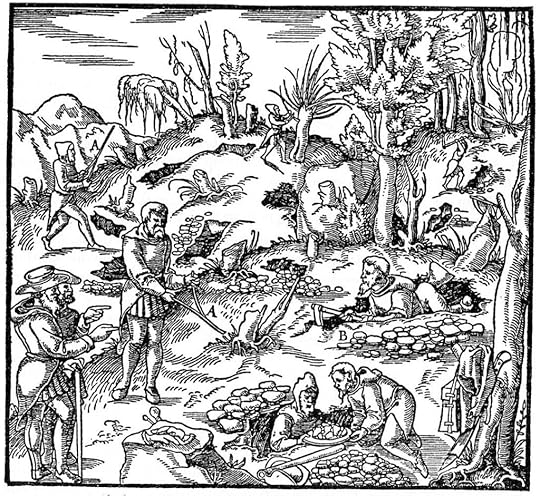 Woodcut of medieval mining from Georgius Agricola’s De Re Metallica, 1556
Woodcut of medieval mining from Georgius Agricola’s De Re Metallica, 1556Extensive medieval tunnels have just been found near Tintern Abbey.
Many medieval castles had escape tunnels for when the castle was under siege. Manorbier Castle in Wales has an escape tunnel entered through the well. I used this detail from Manorbier and my experience of spending 12 hours in an old lead mine in Cumbria in my first novel, Almodis the Peaceweaver (Impress Books, 2015). In the novel, Almodis and her friends escape from a besieged castle through just such a tunnel.
Breze castle in the Loire valley, close to Fontevraud Abbey, has an extensive underground refuge, which probably dates back to the time of Viking raids up the river.
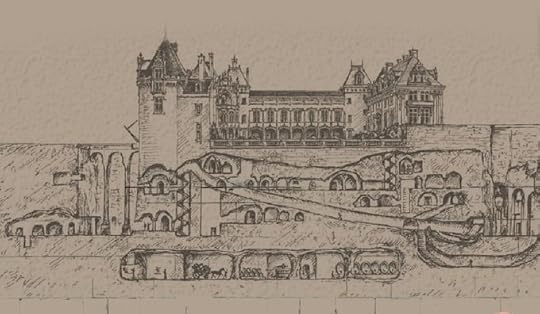 Breze Castle, Loire Valley, France with its underground fortress
Breze Castle, Loire Valley, France with its underground fortressWith no bank vaults and safety deposit boxes the best way to hide your ill-gotten gains was to bury them underground, hence the many spectacular Viking hoard finds.
Roman and medieval mining and underground mine networks are a fascinating topic. My most recent novel, The Anarchy (Impress Books, 2020), features the Roman gold mines at Dolaucothi in Wales. In my descriptions of medieval mining I drew on Georgius Agricola’s 16th century book De re metallica. I was introduced to this book by my friend, Alan Smith, who was also one of the people I spent 12 hours underground with in the old lead mine in Cumbria. More on that experience here including my text, Silent Running.
To celebrate World Book Day my publisher, Impress Books, are offering 10% discount throughout March on books purchased from their website or you can choose instead to have them donate a book to a charity working with refugees.
February 13, 2021
Surviving Vikings, rodents, and war
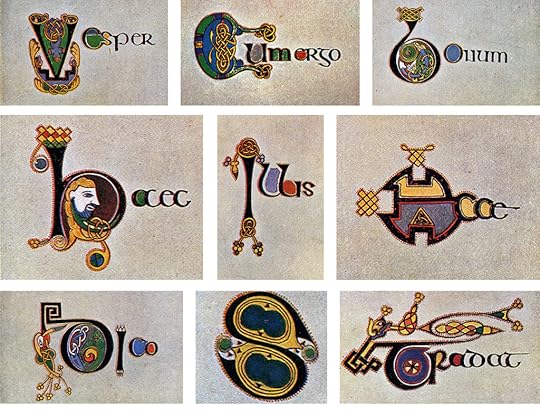 Artist Helen Campbell d’Olier’s reproductions of decorated capitals from the 8th century Book of Kells. The Book of Kells was stolen in 1007 but retrieved after being buried in the ground and stripped of its gold covers. The monks who created it, probably on the island of Iona, relocated to Kells in Ireland after a series of devastating Viking raids.
Artist Helen Campbell d’Olier’s reproductions of decorated capitals from the 8th century Book of Kells. The Book of Kells was stolen in 1007 but retrieved after being buried in the ground and stripped of its gold covers. The monks who created it, probably on the island of Iona, relocated to Kells in Ireland after a series of devastating Viking raids.In my most recent lecture for MA Poetics of Imagination at Dartington Arts School, I considered the production of medieval books. I hope some of the students are now busy making their own writing surfaces, inks and pigments.
To survive into the 21st century these medieval books had to run the gauntlet of flood, fire, war, revolution, rodents, Vikings, and Nazi looters.
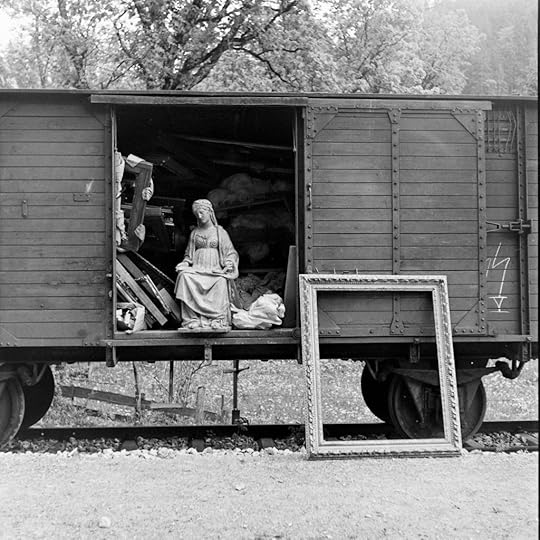 Looted art found at the Nazi mountain refuge in Obersalzburg included two of the most important medieval manuscripts in the world, the Duc de Berry’s Tres Riches Heures and the Book of Hours of Queen Jeanne de Navarre.
Looted art found at the Nazi mountain refuge in Obersalzburg included two of the most important medieval manuscripts in the world, the Duc de Berry’s Tres Riches Heures and the Book of Hours of Queen Jeanne de Navarre.I found Christopher de Hemel’s excellent book Meetings with Remarkable Manuscripts to be a key resource on this fascinating subject.
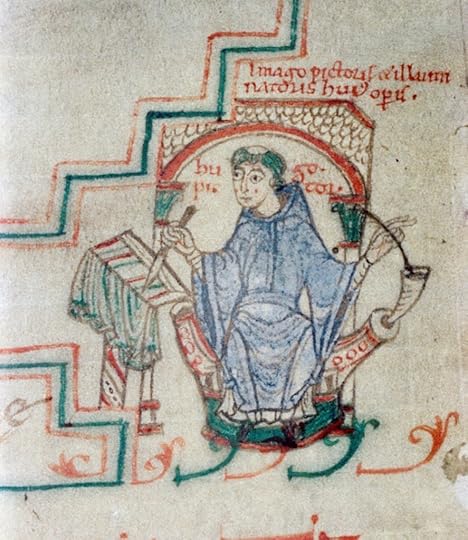 Hugo Pictor’s self-portrait, making a book in the 11th century.
Hugo Pictor’s self-portrait, making a book in the 11th century.
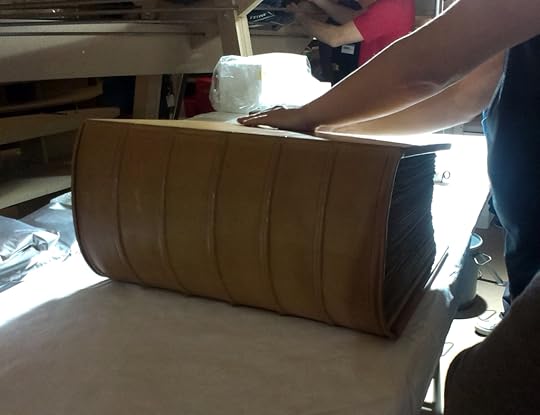 The enormous 8th century Codex Amiatinus is approximately the weight of a 12-year-old child, with 2,000 parchment pages made from 515 sheep and goat skins. It was created by a team of scribes working at the Monkwearmouth-Jarrow Abbey in northern England where Bede lived.
The enormous 8th century Codex Amiatinus is approximately the weight of a 12-year-old child, with 2,000 parchment pages made from 515 sheep and goat skins. It was created by a team of scribes working at the Monkwearmouth-Jarrow Abbey in northern England where Bede lived.Many medieval manuscripts have been digitised and can be explored online. Here’s a selection:
Bibliotheque National de France Digital Library
January 21, 2021
Of things I’d rather keep in silence I must sing
I’m currently preparing a teaching session for MA Poetics of Imagination at Dartington Arts School on the troubadours and trobairitz, which put me in mind of a wonderful writing residency I had a few years ago in the beautiful medieval village of Saint-Cirq-Lapopie in France.
In 2016, I collaborated with artist Tania Candiani on an art project in the Lot Valley in France for the opening night of the Exoplanet Lot exhibition. The exhibition envisaged the Lot Valley as an exoplanet, an alternative human habitation. I wrote a song based on a lyric by the Occitan female troubadour (or trobairitz), Comtesse de Dia. My adaptation replaced the two lovers in Dia’s song with Earth’s lament to the human species. My lyrics were recorded by a local Occitan singer in one of the nearby medieval churches.
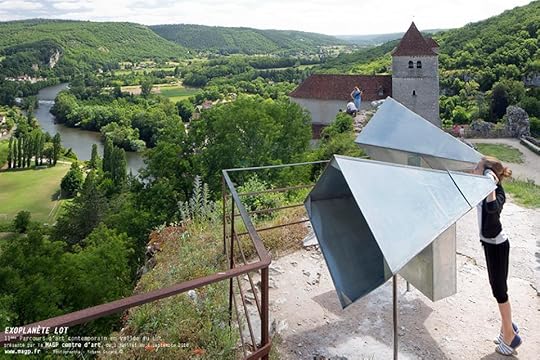 Tania Candiani, Landscape Sound Amplifier, Site specific installation, Exoplanet Lot, Saint-Cirq-Lapopie, France, 2016. Photo: Yohann Gozard. Courtesy of the artist. Exoplanet Lot was organised by Maison des Arts Georges et Claude Pompidou, Cajarc.
Tania Candiani, Landscape Sound Amplifier, Site specific installation, Exoplanet Lot, Saint-Cirq-Lapopie, France, 2016. Photo: Yohann Gozard. Courtesy of the artist. Exoplanet Lot was organised by Maison des Arts Georges et Claude Pompidou, Cajarc.Candiani installed the amplification sculpture pictured here to enable people to listen from the clifftop at Saint-Cirq-Lapopie to the song resonating in the Lot Valley below. You can listen to it here.
Chant Trobairitz, made for Tania Candiani, Landscape Sound Amplifier, 2016. Lyrics by Tracey Warr, adapted from a song by the Comtesse de Dia.My lyrics were:
Earth’s Lament
Of things I’d rather keep in silence I must sing
so bitter do I feel toward you
whom I love more than anything.
You left me for another planet
my forests silent, my seas emptied.
Come home now. I have healed the scars you graved.
It’s not right another celestial body takes you away from me.
Remember how it was with us in the beginning!
Come home. We could still have much time together
Before the death throes of the sun begin.
I send you there, on your exoplanet,
this song as messenger and delegate.
Come home my lovers, my humans.
My song lyrics are published in English in my book The Water Age and Other Fictions, which is available from bookshop.org and other outlets.
The Comtesse de Dia’s original song ‘A chantar m’er…’ is the only trobairitz poem to survive with its music intact. You can find an English translation here and see Meg Bogin’s book The Women Troubadours (W.W. Norton, 1980).
January 16, 2021
Nest ferch Rhys
Video interview with me by Ellie Daniels on researching my latest historical novel, The Anarchy, is here.
We discuss the story of Nest ferch Rhys, the heroine of my story, and how I set about researching early medieval Welsh history. I drew on the scant primary sources on Nest – Brut y Tywysogion (Chronicle of the Princes) and Gerald of Wales. And then I researched around Nest, finding out about the people she encountered including Henry I, King of England; reading medieval historians such as Orderic Vitalis and William FitzStephen; looking at medieval objects and manuscript illuminations; visiting medieval castles in Pembrokeshire and Carmarthenshire.
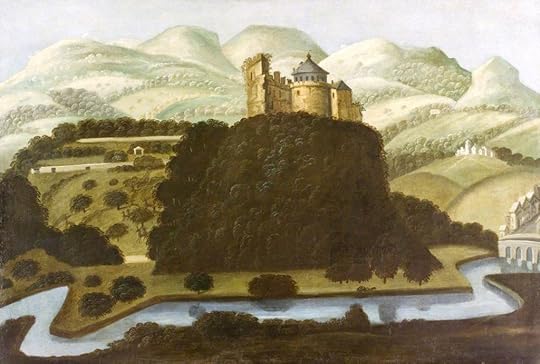 Anonymous 18th century painting of Dinefwr Castle. National Trust, public domain via Wikimedia Commons.
Anonymous 18th century painting of Dinefwr Castle. National Trust, public domain via Wikimedia Commons.Dinefwr was the chief seat of the Welsh kingdom of Deheubarth. Nest’s father, Rhys ap Tewdwr was the last independent king of Deheubarth and was killed by Normans in 1093. Nest’s brother Gruffudd ap Rhys fought to regain his father’s kingdom. Nest’s sister-in-law Gwenllian led a Welsh army against the Normans at Kidwelly Castle, was defeated in the battle, and beheaded along with two of her sons. However, Gwenllian became the battlecry for the Welsh warriors and her widower and Nest’s brother, Gruffudd, along with the princes of Gwynedd, achieved a notable victory against the Normans at Crug Mawr in 1136. Rhys ap Gruffudd, Gruffudd and Gwenllian’s son and Nest’s nephew, later retook much of Deheubarth from the Normans and rebuilt Dinefwr.
Nest herself was mistress of the Norman king, Henry I; wife of the Norman steward of Pembroke Castle, Gerald FitzWalter; kidnapped by the Welsh prince, Owain ap Cadwagn; and then wife to a second Norman, Stephen de Marais, steward of Cardigan Castle. My trilogy, Conquest, gives a fictional account of her turbulent life.
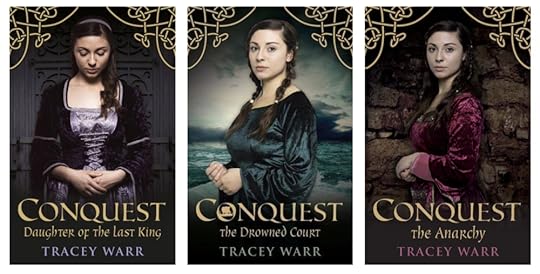 The Conquest trilogy, published by Impress Books.
The Conquest trilogy, published by Impress Books.
November 7, 2020
The Anarchy – video interview
Just posted – a video interview with me on writing The Anarchy with editor Ellie Daniel. We discussed castles in Wales, the little-known women of early medieval history, research for historical fiction, and the character of King Henry I.
My latest newsletter is now available. If you are not already on my mailing list you can sign up on this website.
October 17, 2020
The Anarchy out now in paperback
It is available to order at last!
The e-book of my latest novel, The Anarchy, was published in June, but due to coronavirus disruptions for printers, distributors, and publishers, the paperback edition is only just now reaching many online retailers. The Anarchy is the final book in the Conquest series focused on Nest ferch Rhys, the daughter of the last independent Welsh king after the Norman conquest of England. The series tells the stories of the Welsh struggles against the Normans in the 12th century, and the reign of King Henry I, the youngest son of William the Conqueror.
Paperback available to order here.
You can find an interview with me on my novels on early medieval women here.
My recent articles The Sound of the Middle Ages, published by Historical Novels Review, and The Man Who Walks Behind Satan, published on English Historical Fiction Authors blogspot, draw on some of my research for the novel.
August 22, 2020
Smoke and Mirrors
My review of Sophia Tobin’s novel, A Map of the Damage, is Editor’s Choice in the new issue of Historical Novels Review. ‘A scintillating novel of smoke and mirrors set in the glass-loaded Mirrormakers Club in London…. The novel vividly confronts us with the physical damage of the Blitz and makes us alive to the emotional damage we are capable of inflicting upon one another.’
August 11, 2020
The Sound of the Middle Ages
I look at the now deserted and stagnant lavoirs, the communal washing places, in the Lot Valley in France and can almost hear women singing, gossiping about mistresses and neighbours, and slapping wet laundry against the stone papillon slabs. My article, ‘The Sound of the Middle Ages‘, has just been published in Historical Novels Review.
August 4, 2020
Hyperlocal
My latest interview for the Call Centre art research project on the coronavirus pandemic is with artist Tine Bech. We contemplated the pull of home and the imperative to move out from home. We discussed our new sense of hyperlocal arising from the lockdown. You can see a summary of our conversation and more on the Call Centre project here and the filmed interview here.
July 5, 2020
Wu Wei Workshop
Wu Wei is the sense of letting go, of letting yourself be spacious so that the universe can come in.
[image error]Tracey Warr, Gyre. Image: Yuri Tama.
Friday 31 July 2020 19.00-21.30 & Saturday 1 August 2020 11.00-18.00 (European time)
On Zoom
50 euros, Registration deadline: 23 July 2020, info@gresolart.com
(English, Castellano and Catalan spoken. Flyer also available in Castellano and Catalan.)
wu-wei-workshopDownload
The three core sessions in the workshop are:
The Formless – Exploring the fluid energy of the body with meditation, Taiji, Qigong, and Yijing teacher Tew Bunnag.
Beyond Thought – Actions to reach areas of consciousness that are beyond logical thought modes and habits with artist Denys Blacker.
Writing With – Writing with and from the body and with the space you are in. Automatic and durational writing with writer Tracey Warr.



